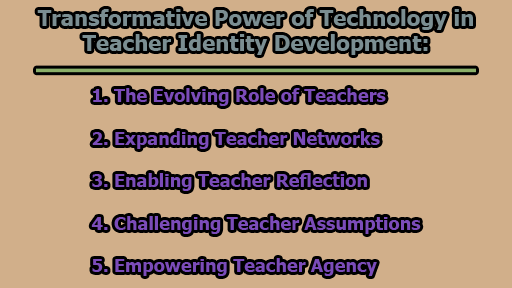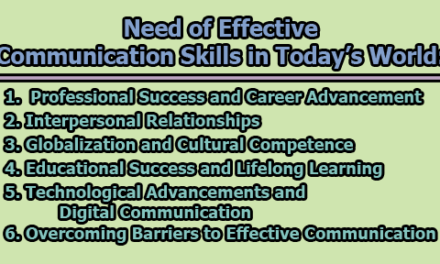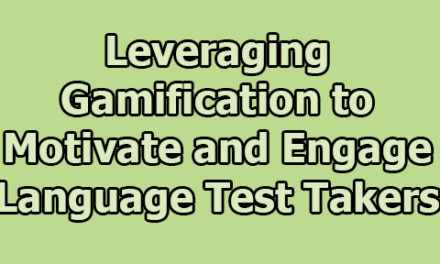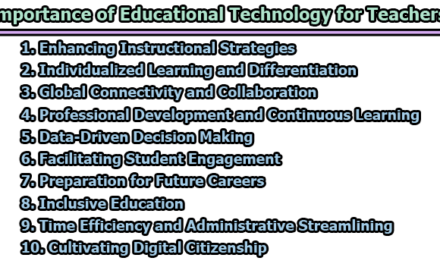Transformative Power of Technology in Teacher Identity Development:
Technology has profoundly reshaped various aspects of our lives, and education is no exception. In recent years, the integration of technology into the educational landscape has brought about significant changes in teaching methodologies, student engagement, and learning outcomes. However, one often overlooked aspect of this transformation is its impact on teacher identity development. This article explores the transformative power of technology in teacher identity development, and empowering them to meet the evolving demands of education.
1. The Evolving Role of Teachers: The role of teachers has always been central to the educational process. Traditionally, they were seen as the primary sources of knowledge and facilitators of learning, responsible for delivering content and ensuring that students acquired the necessary skills and information. However, the advent of technology has shifted this paradigm in several ways.
Firstly, technology has expanded the sources of knowledge available to both teachers and students. The internet, online courses, and digital libraries have made information more accessible than ever before. Consequently, teachers are no longer the sole repositories of knowledge; instead, they become guides, mentors, and facilitators, helping students navigate the vast sea of information.
Secondly, the traditional classroom setup is no longer the only way to deliver instruction. Technology has opened the door to various instructional models, including online learning, blended learning, and flipped classrooms. These new approaches require teachers to adapt to different roles, such as curators of digital resources, online community managers, and guides for self-paced learning.
Given these profound shifts in the educational landscape, it is crucial to understand how technology impacts teacher identity development, enabling them to thrive in a rapidly changing environment.
2. Expanding Teacher Networks: One of the most remarkable ways technology impacts teacher identity development is by expanding their networks. Historically, teachers were confined to their local communities, and their professional growth was often limited to interactions with colleagues within their school or district. However, technology has broken down these geographical barriers and opened up new horizons.
Online platforms, social media, and digital tools have provided educators with the means to connect with other teachers, experts, and communities worldwide. This expansion of teacher networks has far-reaching implications. Teachers can now access and share resources, ideas, feedback, and support with colleagues from diverse backgrounds, fostering a culture of collaboration and continuous learning.
Moreover, these interactions expose teachers to a wealth of diverse perspectives and practices. They can learn from educators in different locations, disciplines, and cultures, enriching their own teaching methods and approaches. This exposure to diversity can enhance teacher identity by creating a sense of belonging, recognition, and affirmation. When teachers realize that they are part of a global community of educators, their professional identity gains depth and significance.
3. Enabling Teacher Reflection: Reflection is a fundamental component of teacher development. It is the process of examining and evaluating one’s teaching experiences, actions, and outcomes. Through reflection, teachers gain insights into what works in the classroom and what doesn’t, leading to continuous improvement in their practice.
Technology plays a pivotal role in supporting teacher reflection by providing data, evidence, and feedback that help teachers identify their strengths, weaknesses, opportunities, and challenges. For example, teachers can use digital portfolios to showcase their work, video recordings to analyze their teaching practices, and online surveys to gather feedback from students, peers, and parents.
Additionally, technology creates spaces and opportunities for dialogue, discussion, and inquiry. Teachers can participate in online forums, webinars, and social media discussions, where they can engage in conversations with other educators and mentors. These interactions provide valuable insights and feedback, leading to increased self-awareness, confidence, and commitment.
4. Challenging Teacher Assumptions: Teacher assumptions are the beliefs and expectations that educators hold about themselves, their students, their curriculum, and their context. These assumptions play a significant role in shaping teacher decisions, actions, and reactions in the classroom. Technology has the capacity to challenge and broaden these assumptions, encouraging teachers to embrace new perspectives and ideas.
By exposing teachers to new information, experiences, and perspectives, technology can contradict or question their existing views. For instance, through technology, teachers can access diverse and authentic sources of knowledge, such as student data, research findings, or global issues. This exposure to a broader scope of information encourages teachers to critically evaluate their practices and beliefs.
Moreover, technology allows teachers to engage with different and complex learning scenarios. The shift towards online or blended learning, project-based learning, and personalized learning challenges teachers to adapt their practices. These new approaches require teachers to think outside the traditional teaching box, fostering critical thinking, creativity, and innovation. Challenging teacher assumptions can lead to personal and professional growth, further strengthening their teacher identity.
5. Empowering Teacher Agency: Teacher agency refers to the ability and willingness of educators to take control of their teaching and learning. It is the power to make choices, influence classroom practices, and shape educational policies. The integration of technology into education has the potential to empower teacher agency in several ways.
Firstly, technology provides teachers with more autonomy and flexibility in their teaching practices. They can design and deliver customized and differentiated instruction, assessments, and feedback, tailoring their approach to meet the individual needs of their students. This level of customization enhances their sense of agency and efficacy.
Furthermore, technology enables teachers to advocate and collaborate for change and improvement in their schools, systems, or societies. They can use digital platforms and tools to communicate their vision, mobilize support, and effect change. For instance, teachers can lead initiatives to improve the use of technology in the classroom, address equity and access issues, or influence educational policy.
Empowering teacher agency not only enhances professional development but also fosters teacher identity. When teachers are encouraged to express their voice, values, and vision in their profession and context, they are more motivated, satisfied, and impactful.
In conclusion, the integration of technology into education has ushered in a new era, transforming the role of teachers and redefining the landscape of education. The impact of technology on teacher identity development cannot be overstated. By expanding teacher networks, enabling teacher reflection, challenging teacher assumptions, and empowering teacher agency, technology is shaping not only the teaching profession but also the teachers themselves.
As educators navigate a rapidly changing educational landscape, technology serves as a valuable ally, supporting them on their journey of self-discovery and professional growth. The transformative power of technology in teacher identity development is a testament to the adaptability and resilience of teachers in the face of evolving educational paradigms. As technology continues to advance, its impact on teacher identity development will only become more profound, ensuring that educators remain at the forefront of innovation and excellence in education.

Assistant Teacher at Zinzira Pir Mohammad Pilot School and College










